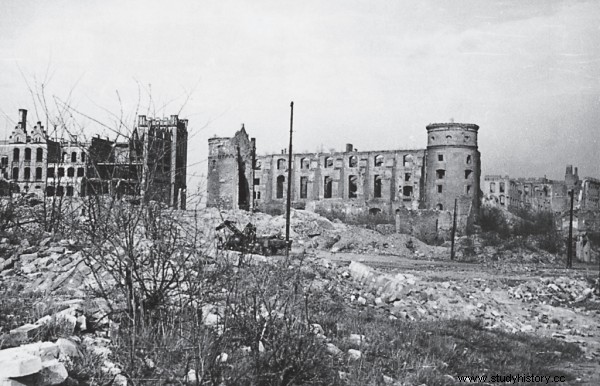Does the Amber Room still exist or did it burn down during the British attack on Królewiec in 1944? After World War II, there were witnesses who said that they saw the burned remains of the treasure for themselves ...
Following Badowski, we will quote excerpts from two letters, the content of which relates directly to the Amber Room and its fate after the August Allied air raids on Königsberg.
"Everything is lost"
Liesel Amm, a history teacher from Berlin, a friend of Rohde's daughter during the war, who often visited the director's house, after watching Badowski's film, writes in a letter to the filmmakers sent to the State Committee for Television at the Council of Ministers of the GDR, which passed the letter to Poles:
(...) At one of the dinners, it must have been sometime in 1943, Dr. Rohde told me that the Amber Room had been brought to the castle. Until then, I didn't know it existed . Since I was very interested in works of art, which was related to my profession, Dr. Rohde promised to show me this room, which was to be exhibited in the Königsberg castle.
He kept his promise. I was one of the first to see the treasure. Dr. Rohde showed it to me personally. Several weeks have passed. During one of the following dinners, Dr. Rohde said that due to the possible raids, the chamber should be moved to the castle cellars. The cellar vaults in the castle were so thick (built by the knights of the Order in 1255) that nothing could have happened to the Amber Room.
The biggest air raids took place in the summer of 1944. Konigsberg gave the impression of one enormous rubble. After a night fire, during the second of the night raids, I went downtown in search of relatives and friends. Around noon I found myself in the courtyard of the castle. Here I met Dr. Rohde, who must have come shortly before me. (…)

Königsberg Castle was destroyed during air raids at the end of World War II. Was there the Amber Room there at that time?
He had a crushed appearance, his face ashen. We exchanged a short greeting and then I asked the question:"What about the Amber Room?" He replied, "Everything is lost." He led me towards unfamiliar cellars, and I saw a molten mass with charred pieces of wood in it. Dr. Rohde was devastated. We never talked about the Amber Room after that. (…)
Thanks to Polish Television, I learned that after many years people are still looking for traces of the Amber Room. I can only explain it to myself that Dr. Rohde, in the first instinct of despair, showed me that night after the fire, the place where the Amber Room fell victim to the flames. For fear of responsibility, however, he ignored this fact to the then Gauleiter Erich Koch.
He was also frightened later when he collaborated with Soviet art experts. After all, his most precious treasure was under his supervision. The amber chests, which were later to be seen in the courtyard of the castle, may have been chests with amber collections belonging to Dr. Rohde. I also knew this collection. The doctor himself showed it to me.
Bombs and the scent of incense
After the TV film was broadcast, and before the book was published, Badowski published an article on the search for the Amber Chamber in the then weekly magazine Przekrój in Kraków. It contained a letter from Liesel Amm. Then Edward Appel from Gdynia, who was in the city during the second air raid on Königsberg in August, spoke up. Appel wrote:
I was in an apartment that night, 200-300 meters from the Königsberg castle. Late at night, a few minutes after the alarm was announced, I went to a small balcony (I was afraid to go to the shelter because I stayed in the apartment illegally), from where I watched the sky dotted with "Christmas trees" - lighting rockets.
The view was so beautiful that despite the dread of the situation, I couldn't take my eyes off it. And the detonations of the bombs, interrupted by the roar of anti-aircraft guns, were getting closer. Only at the sight of a burning bomber that had fallen in a further district of the city, I went down to the ground floor, and then to an empty street, brightly lit by fires. When I heard the whistle of falling bombs, I decided to take a risk.
I ran up the concrete stairs leading to one of the shelters. A blast of a close detonation threw me at a group of people (mostly in SA uniforms) trying to get out of the underground. Only thanks to that I didn't break myself. But I was stunned and when the raid was over, I was one of the first to run outside. The house above the shelter was on fire.

The text is an excerpt from Włodzimierz Antkowiak's book "Poszukiwacze zaginanego chamnaty", which has just been published by the Bellona publishing house.
At the end of the alley I met a Frenchman dragging a beam and asking me to help break down a door that was buried in rubble. A dozen women and children spilled out from behind them. The French got lost in the panicked crowd, and I went through the wide-open gate to the castle courtyard.
I don't remember if the lock was on fire or badly broken. But after reading Liesel Amm's letter, I remembered clearly that on one side of the yard was a pile of tanned and smoking crates from which a heavy, thick, yellowish smoke was coming out. I also saw a thick, creamy goo that was coming out of some of the crates and covered the pavement of the courtyard. I was particularly struck by the strong smell that pierced my nostrils, irritating like the smell of… incense!
At the time, I didn't wonder what those crates were. Today - after reading the article and a letter from a teacher from Berlin - I ask myself:wasn't it the Amber Room? If it was in these chests - it burned down in Königsberg.
Masterpieces don't burn?
How to understand these relationships? Until 1989, it was supposed that Liesel Amm might not exist at all, and its alleged description was the product of STASI, the GDR security service, or that Amm made it all up for some reason.
The supposition was justified, because neither Badowski, nor any of the producers of the film The Secret of the Amber Room did not even try to contact the author of the letter, if only to learn more from an eyewitness to the story.
After the fall of the Berlin Wall, the author of the account was found in East Berlin by West German journalists, and in the early 1990s, Amm was shown in the documentary Das Bernsteinzimmer. Ende einer Legende ( The Amber Room. End of a Legend ), made in 1990 by the German documentary filmmaker and writer Maurice Philip Remy.

photo:Lanzi / CC BY-SA 3.0 Journalists conducted an experiment:they burned some amber and what was left of it did not resemble honey at all
Amm repeated to both journalists and Remy everything she had said in the letter. There was one new detail in her account that could not be verified on the letter. Amm told reporters that what she saw in the castle's basement, which is the molten mass that Rohde showed her as the remains of the burnt Chamber, looked like honey .
Journalists conducted an experiment:they burned some amber and what was left of it did not look like honey at all, the melting amber turned into a black-greenish substance. It was completely contrary to Amm's story.
It doesn't necessarily mean that the woman was deliberately lying. It seems that Liesel Amm's account and the conclusions she reached cannot be believed for several reasons, and the most important is one - the thesis that Rohde would have managed to hide the destruction of the Amber Room cannot be defended. It is unimaginable.
Something like that, this kind of catastrophe, could not be concealed not only in Hitler's police state, but in any other country. After all, the castle employees would have to witness the destruction of the Chamber, because most of them probably knew what was buried in the basement of the west wing, packed in boxes, and many probably participated in removing the effects of the castle bombing and the fire caused by it.
Source:
The text is an excerpt from Włodzimierz Antkowiak's book "Poszukiwacze zaginanego chamnaty", which has just been published by the Bellona publishing house.
